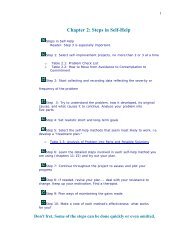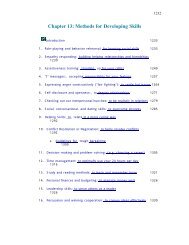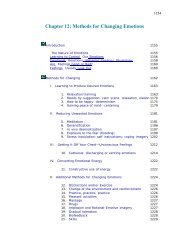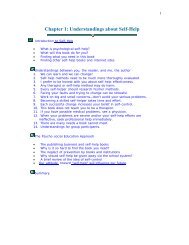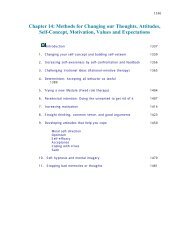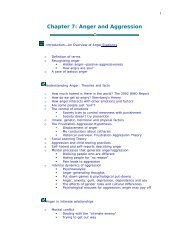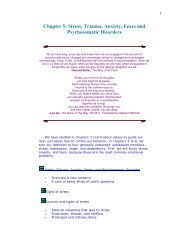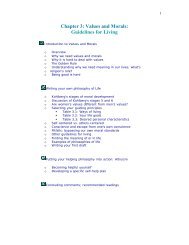Methods for Changing Behaviors - Psychological Self-Help
Methods for Changing Behaviors - Psychological Self-Help
Methods for Changing Behaviors - Psychological Self-Help
You also want an ePaper? Increase the reach of your titles
YUMPU automatically turns print PDFs into web optimized ePapers that Google loves.
habits. The stimulus <strong>for</strong> avoidance responses, such as shyness, may<br />
not be obvious; indeed, there may not be any external event, only a<br />
fleeting thought that you will have to carry on a conversation if you go<br />
to lunch with co-workers. Your avoidance (because it reduces stress)<br />
may occur almost unconsciously, yet the environment provides cues<br />
<strong>for</strong> you to withdraw. Method #9 will help you discover the stimuli<br />
controlling your behavior.<br />
STEP TWO: Avoid situations that lead to unwanted actions.<br />
Provide warning signs. Break the chain early.<br />
We can either avoid an environment entirely or change parts of it<br />
so that it is less likely to produce the unwanted behavior. Examples: if<br />
a group of friends push you to do things you'd rather not do, avoid<br />
them. If you and your parents frequently argue about a certain topic,<br />
steer the conversation away from that topic.<br />
Thoughts and fantasies are frequently triggers <strong>for</strong> our actions.<br />
Thus, dwelling on temptations, as we found out in chapter 4, makes it<br />
harder to resist. Depressive or angry thoughts may give rise to<br />
unwanted actions. Thoughts can be stopped or changed to be more<br />
constructive.<br />
Providing warning signs certainly changes the environment.<br />
Examples: a timer set to ring after one hour of TV viewing, a medical<br />
picture of cirrhosis of the liver placed on the refrigerator door as one<br />
gets out his/her second beer, a picture of a gruesome accident stuck<br />
on the steering wheel until the seat belt is fastened.<br />
It is also helpful to recognize that many unwanted behaviors are<br />
the outcome of an easily recognized series or "chain" of behaviors.<br />
Each step along the chain of events serves as the stimulus <strong>for</strong> the next<br />
step. Examples: Over eating, getting drunk, getting in an argument,<br />
having an affair, etc. For instance, to gorge on cake and ice cream at<br />
home, one has to go to the store, pick up the fattening food, pay <strong>for</strong> it,<br />
store it at home, prepare it, and eat much more than needed. To have<br />
an affair, there is usually a series of events: one would approach an<br />
attractive person, make an ef<strong>for</strong>t to impress him/her, suggest lunch or<br />
a drink, talk about personal matters, do enjoyable things together,<br />
indicate an attraction to the other person, touch each other, go where<br />
you can be alone, be affectionate, get undressed, and "make love."<br />
Obviously, if one wants to avoid an affair, a person had better avoid<br />
the first few steps because it gets harder to stop the further along the<br />
chain one goes. That is, "break the chain early!" Otherwise, one is<br />
beyond self-help! The early steps become the warning signs to stop.<br />
Method #4, relapse prevention, gives the details <strong>for</strong> coping with<br />
temptations and compulsions.<br />
STEP THREE: Provide cues or environments that prompt desired<br />
behavior.<br />
1071



